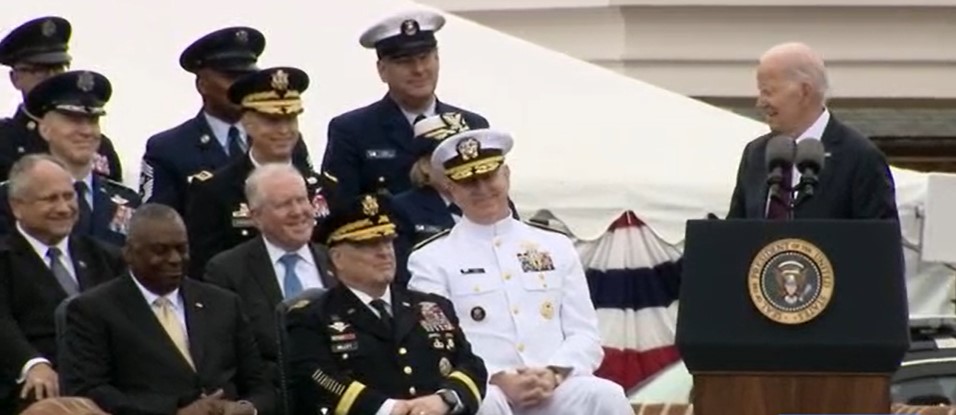armed forces
Top Brass Is On The Run Ahead Of Trump’s Return


From the Daily Caller News Foundation
By Morgan Murphy
With less than a month to go before President-elect Donald Trump takes office, the top brass are already running for cover. This week the Army’s chief of staff, Gen. Randy George, pledged to cut approximately a dozen general officers from the U.S. Army.
It is a start.
But given the Army is authorized 219 general officers, cutting just 12 is using a scalpel when a machete is in order. At present, the ratio of officers to enlisted personnel stands at an all-time high. During World War II, we had one general for every 6,000 troops. Today, we have one for every 1,600.
Right now, the United States has 1.3 million active-duty service members according to the Defense Manpower Data Center. Of those, 885 are flag officers (fun fact: you get your own flag when you make general or admiral, hence the term “flag officer” and “flagship”). In the reserve world, the ratio is even worse. There are 925 general and flag officers and a total reserve force of just 760,499 personnel. That is a flag for every 674 enlisted troops.
The hallways at the Pentagon are filled with a constellation of stars and the legions of staffers who support them. I’ve worked in both the Office of the Secretary of Defense and the Joint Chiefs of Staff. Starting around 2011, the Joint Staff began to surge in scope and power. Though the chairman of the Joint Chiefs is not in the chain of command and simply serves as an advisor to the president, there are a staggering 4,409 people working for the Joint Staff, including 1,400 civilians with an average salary of $196,800 (yes, you read that correctly). The Joint Staff budget for 2025 is estimated by the Department of Defense’s comptroller to be $1.3 billion.
In contrast, the Secretary of Defense — the civilian in charge of running our nation’s military — has a staff of 2,646 civilians and uniformed personnel. The disparity between the two staffs threatens the longstanding American principle of civilian control of the military.
Just look at what happens when civilians in the White House or the Senate dare question the ranks of America’s general class. “Politicizing the military!” critics cry, as if the Commander-in-Chief has no right to question the judgement of generals who botched the withdrawal from Afghanistan, bought into the woke ideology of diversity, equity and inclusion (DEI) or oversaw over-budget and behind-schedule weapons systems. Introducing accountability to the general class is not politicizing our nation’s military — it is called leadership.
What most Americans don’t understand is that our top brass is already very political. On any given day in our nation’s Capitol, a casual visitor is likely to run into multiple generals and admirals visiting our elected representatives and their staff. Ostensibly, these “briefs” are about various strategic threats and weapons systems — but everyone on the Hill knows our military leaders are also jockeying for their next assignment or promotion. It’s classic politics
The country witnessed this firsthand with now-retired Gen. Mark Milley. Most Americans were put off by what they saw. Milley brazenly played the Washington spin game, bragging in a Senate Armed Services hearing that he had interviewed with Bob Woodward and a host of other Washington, D.C. reporters.
Woodward later admitted in an interview with CNN that he was flabbergasted by Milley, recalling the chairman hadn’t just said “[Trump] is a problem or we can’t trust him,” but took it to the point of saying, “he is a danger to the country. He is the most dangerous person I know.” Woodward said that Milley’s attitude felt like an assignment editor ordering him, “Do something about this.”
Think on that a moment — an active-duty four star general spoke on the record, disparaging the Commander-in-Chief. Not only did it show rank insubordination and a breach of Uniform Code of Military Justice Article 88, but Milley’s actions represented a grave threat against the Constitution and civilian oversight of the military.
How will it play out now that Trump has returned? Old political hands know that what goes around comes around. Milley’s ham-handed political meddling may very well pave the way for a massive reorganization of flag officers similar to Gen. George C. Marshall’s “plucking board” of 1940. Marshall forced 500 colonels into retirement saying, “You give a good leader very little and he will succeed; you give mediocrity a great deal and they will fail.”
Marshall’s efforts to reorient the War Department to a meritocracy proved prescient when the United States entered World War II less than two years later.
Perhaps it’s time for another plucking board to remind the military brass that it is their civilian bosses who sit at the top of the U.S. chain of command.
Morgan Murphy is military thought leader, former press secretary to the Secretary of Defense and national security advisor in the U.S. Senate.
armed forces
Trump rebuilds the ranks: Army crushes 2025 recruitment goal early

 MxM News
MxM News
Quick Hit:
The Army has already exceeded its 2025 recruiting goal of 61,000 troops—four months ahead of schedule—as the Trump administration’s rollback of woke policies draws thousands back to military service.
Key Details:
-
The Army’s 2025 recruiting goal was 61,000—higher than last year’s 55,000—and has already been met with more than four months remaining in the fiscal year. Officials report a 56% increase in average daily enlistment rates over last year.
-
Army Secretary Daniel Driscoll thanked Trump and Hegseth, saying their “decisive leadership” and “putting soldiers first” contributed to the record-breaking numbers.
-
Hegseth has aggressively pushed to eliminate leftist cultural initiatives in the military, including moves to administratively separate transgender troops and rename a Navy ship previously dedicated to gay rights icon Harvey Milk.
Diving Deeper:
The U.S. Army has reached a major milestone ahead of schedule—signing up 61,000 new recruits in fiscal year 2025, effectively smashing its annual goal months before the September 30th deadline. The achievement marks a dramatic shift after years of underperformance and is being touted as a vindication of the Trump administration’s efforts to reorient the military away from progressive social engineering and back toward warfighting readiness.
In a Wall Street Journal op-ed Tuesday, Army Secretary Daniel Driscoll praised the recruiting corps, attributing their success to both boots-on-the-ground determination and high-level support. “I’m incredibly proud of our U.S. Army recruiters and drill sergeants,” he said. “Their colossal efforts and dedication to duty helped the U.S. Army accomplish our FY25 annual recruiting goal a full four months ahead of schedule.” Driscoll continued, “I want to thank the commander in chief, President Trump, and Secretary of Defense Hegseth for their decisive leadership and support.”
The Army’s target of 61,000 recruits was a notable jump from last year’s 55,000 goal. Officials say that as of this month, daily enlistment figures are tracking 56% higher than the previous year.
Driving the increase, many believe, is the sweeping overhaul of military culture underway under Defense Secretary Pete Hegseth. Hegseth has made no secret of his intent to steer the armed forces away from what he calls “woke and weak” policies. That includes the Pentagon’s past focus on gender identity politics, climate initiatives, and mandatory diversity training—priorities Hegseth sees as incompatible with combat readiness.
“We are leaving wokeness and weakness behind,” Hegseth declared during remarks last month at the Special Operations Forces Week convention in Tampa. “No more pronouns, no more climate change obsession, no more emergency vaccine mandates. No more dudes in dresses. We’re done with that s***.”
Hegseth emphasized a military rooted in “lethality, meritocracy, accountability, standards and readiness,” and added pointedly, “Our combat formations don’t need to look like Harvard University—they need to look like killers.”
In line with that shift, Hegseth also this week ordered the Navy to remove Harvey Milk’s name from a replenishment ship. The vessel had been named in honor of Milk, a gay rights activist and former Navy officer who was elected to the San Francisco Board of Supervisors in 1977 before being assassinated a year later.
The directive aligns with what Hegseth calls “warrior culture” and the broader mission to reflect Trump administration priorities across the military’s assets and institutions. The Pentagon has yet to confirm a new name for the USNS Harvey Milk, and a spokesperson said reviews are ongoing.
The Army is set to mark its 250th anniversary on June 14th—a symbolic moment, officials say, as it reclaims its footing and begins to rebuild the force from a position of strength.
armed forces
New Trump-Pentagon ad resets mission: end wokeness, win wars

Quick Hit:
The Pentagon released a dramatic new ad Sunday featuring President Trump and Defense Secretary Pete Hegseth, highlighting the end of woke policies in the military and a renewed focus on strength, discipline, and warfighting.
Key Details:
-
The ad, titled Peace through Strength, features intense training and combat scenes, underscored by speeches from Trump and Hegseth.
-
“No more distraction, no more electric tanks, no more gender confusion, no more climate change worship,” Hegseth proclaims, signaling a sharp pivot from recent Pentagon policies.
-
Trump promises that under his leadership, U.S. military success will be defined “not only by the battles we win, but also by the wars we end,” calling for peace built on American strength.
NEW U.S. MILITARY AD HITS HARD🇺🇸
"We are laser focused on our mission of warfighting… Our friends will respect us, our enemies will fear us, and the whole world will admire the unrivaled greatness of the United States Military" pic.twitter.com/jdm3MikswO
— The White House (@WhiteHouse) May 27, 2025
Diving Deeper:
The Pentagon launched a forceful new recruitment and branding campaign over Memorial Day weekend, spotlighting the military’s return to fundamentals under the leadership of Defense Secretary Pete Hegseth and President Donald Trump. The minute-long ad, titled Peace through Strength, premiered Sunday at the Coca-Cola 600 NASCAR event and was simultaneously posted to the Department of Defense’s social media accounts.
Using fast-paced training footage and dramatic music, the ad showcases troops in battlefield simulations and highlights a no-nonsense message from the Trump administration. Hegseth opens with a clear declaration: “No more distraction, no more electric tanks, no more gender confusion, no more climate change worship. We are laser-focused on our mission of warfighting.”
The video includes remarks from Trump affirming his vision for a military built on discipline and deterrence. “Through our power and might, we will lead the world to peace,” he says. “Our friends will respect us. Our enemies will fear us. And the whole world will admire the unrivaled greatness of the United States military.”
The ad was produced using previously recorded training footage, according to a Pentagon spokesperson who spoke to The New York Post.
Hegseth also makes a direct appeal to America’s youth, praising “incredible” young men and women “giving up the best years of their lives” to defend the country. He closes the ad with a quote that underscores the values behind the mission: “We don’t fight because we hate what’s in front of us. We fight because we love what’s behind us.”
The backdrop to the ad is a recruiting crisis that had plagued the military under Biden. In fiscal year 2022, the U.S. Army fell short by roughly 25% of its enlistment target. Similar gaps were recorded across other branches in 2023, with both the Navy and Air Force reporting thousands fewer recruits than needed.
Reversing that trend has been a key objective for Hegseth. He has made it clear that returning to a warrior culture—and scrapping the distractions of social experimentation—is central to solving the problem.
The ad’s release comes just days after the House passed the One Big Beautiful Bill Act, which adds $150 billion in new military funding. That package includes investments in shipbuilding, defense modernization, and Trump’s space-based Golden Dome missile defense initiative.
Together, the new ad and the legislation serve as a one-two punch from the Trump administration, signaling a full-spectrum push to rebuild, rearm, and reinspire the U.S. Armed Forces.
-

 Health1 day ago
Health1 day agoLast day and last chance to win this dream home! Support the 2025 Red Deer Hospital Lottery before midnight!
-

 conflict1 day ago
conflict1 day ago“Evacuate”: Netanyahu Warns Tehran as Israel Expands Strikes on Iran’s Military Command
-

 Alberta2 days ago
Alberta2 days agoAlberta’s grand bargain with Canada includes a new pipeline to Prince Rupert
-

 Energy24 hours ago
Energy24 hours agoKananaskis G7 meeting the right setting for U.S. and Canada to reassert energy ties
-

 Business23 hours ago
Business23 hours agoCarney’s Honeymoon Phase Enters a ‘Make-or-Break’ Week
-

 Energy1 day ago
Energy1 day agoCould the G7 Summit in Alberta be a historic moment for Canadian energy?
-

 Aristotle Foundation1 day ago
Aristotle Foundation1 day agoThe Canadian Medical Association’s inexplicable stance on pediatric gender medicine
-

 Business2 days ago
Business2 days agoCarney’s European pivot could quietly reshape Canada’s sovereignty






